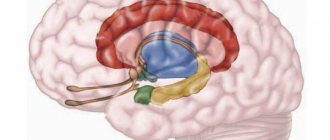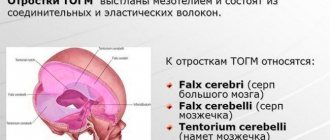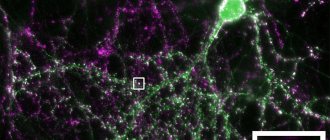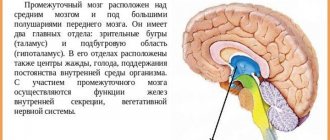Author's rating
Author of the article
Smirnova Olga Leonidovna
Neurologist, education: First Moscow State Medical University named after I.M. Sechenov. Work experience 20 years.
Articles written
94
It is important for everyone to know which part of the brain is responsible for memory and what influences this process. Every day we receive a lot of information, some of which is remembered. Why do some memories remain in memory and others not, what is the mechanism of action of memory?
Brain topography
Each part of the brain has its own functions. For example, information obtained through vision
is analyzed in the occipital region of the brain.
And the movement
is controlled by a fairly narrow strip of nervous tissue that stretches from the top of the head to the ear, like the earpiece of headphones.
Brain training
Is your memory failing? It’s not surprising, because she suffers without load in the same way as her muscles. Memory development exercises will help you - you can start doing them at any age.
At the same time, vision, hearing, movement, and all tactile sensations are controlled in a mirror way.
So, if a person has a stroke in the left hemisphere, the motor functions of the right side of the body are impaired. Next to the motor area is the area where tactile sensations
.
Therefore, often when the brain is damaged, a person simultaneously loses both the ability to move and the ability to feel. The perception of auditory information
occurs in the temporal region of the brain.
In right-handed people, the left temporal lobe is responsible for understanding words and expressing one's own thoughts. Right temporal lobe – helps to hear music and identify various noises. The area of the brain where the visual and auditory areas meet is responsible for the function of reading
- converting visual images into sounds.
Where is the memory
Memory is the ability to remember, accumulate and retrieve received information. How much a person can remember depends on his attention.
Memory is formed by several parts of the brain: the cerebral cortex, the cerebellum, and the limbic system. But it is most influenced by the temporal lobes of the brain. The process of remembering occurs in the hippocampus. If the temporal region is damaged on one side, then memory becomes worse, but if there is damage in both temporal lobes, the memorization process stops completely.
The functioning of memory depends on the state of neurons and neurotransmitters that provide communication between nerve cells. They are concentrated in the hippocampus region. Acetylcholine is also classified as a neurotransmitter. If these substances are not enough, then memory deteriorates significantly.
The level of acetylcholine depends on the amount of energy produced during the oxidation of fats and glucose. Neurotransmitters are concentrated in the organ in smaller quantities if a person is stressed or suffers from depression.
Frontal lobes – “management company”
The largest part of the brain is the frontal lobe. One of the main functions of this part of the brain is planning
- the ability to perform actions that require several different actions.
In order for the sequence of actions to be correct, the frontal lobes perform another function - organizational
.
Additionally, the frontal lobes play an important role in the control of emotions
.
In the deep parts of the brain there are areas responsible for primitive emotions: hunger, aggression and sexual desire. These structures send messages to the parts of the brain responsible for action. The frontal lobes control this process through the so-called stop function
. So, for example, if emotions dictate to hit the boss, the frontal lobes signal: “Stop, or you will lose your job.” This function is for notification purposes only. The frontal lobes, of course, cannot turn off emotions and stop actions.
Soldiers of the invisible front
At the back of the brain is the cerebellum
.
Its volume is approximately one-eighth the size of the cerebral hemispheres. Despite its small size, this part of the brain controls coordination of movements
(the joint work of all muscles) and
the sense of balance
.
Thanks to the work of the cerebellum, a person can stand on his feet, maintain balance and move around. The brain stem
is located under the cerebral hemispheres and behind the cerebellum.
It connects the spinal cord and brain and controls all the functions that are necessary to maintain life in the body. The trunk is responsible for the involuntary work of muscles during breathing, heartbeat, food digestion and blood circulation. It works automatically and without interruption
.
How to prolong youth?
One of the mechanisms leading to aging is the death of nerve cells. The less a person strains his brain, the larger this process becomes. Find out how to stop this process and delay old age.
The brain stem is also responsible for sorting and distributing messages that the brain receives from the rest of the body.
Another notable area of the brain is the hippocampus
.
This paired formation, located in the temporal lobes of the hemispheres, controls memory
.
More precisely, by transferring information from short-term memory storage to long-term memory. The pituitary gland
is located on the lower surface of the brain - in a special bony cavity called the sella turcica.
The size of the pituitary gland is very small - no more than a pea. Its task is to control the production and release of all hormones
in the body.
Produces the pituitary gland and its own hormones - for example, growth hormone. The hypothalamus
is located practically in the geometric center of the brain.
It synchronizes the work of the nervous and endocrine systems of the body, working closely with the pituitary gland. For example, it is responsible for a kind of internal thermometer that maintains the temperature of the entire body
. If it increases, the hypothalamus sends a complex neurohormonal message that stimulates sweating. If it decreases, it gives a command for muscle tremors.
PsyAndNeuro.ru
Imagine that this morning you were woken up by an incomprehensible sound emanating from a strange small rectangle with bright inscriptions “snooze” and “turn off”. The hand automatically reached out and pressed the word “turn off” and the strange sound stopped. You finally opened your eyes and found yourself in an unfamiliar room. You stood up, lowered your legs down and with horror felt with them an incomprehensible hairy creature looking at you with two huge eyes. Confused, you politely walked around him and headed towards the hole in the wall opposite. Behind it lay countless huge boxes, between which some rattling smaller boxes were quickly moving. You wanted to take a closer look at them, but you hit your forehead hard against an invisible barrier. From pain and fear, you sank to the floor and clasped your head in your hands, not understanding what was happening around you and who exactly you were. This is most likely how your every day would begin if, by an unfortunate coincidence, you completely lost the mechanisms of long-term memory functioning. A depressing picture, isn't it?
Indeed, the ability to record, store, and use information gained through experience represents one of the most important evolutionary acquisitions of our species. The totality of our memories essentially defines who we are. We know what our name is, what gender we are, how old we are, where we live, what we and our parents look like. How we react to different life situations depends on how we acted in similar situations in the past. All this will be lost if we lose long-term memory.
As some have probably already noticed, in the example given at the beginning of the article, there was a loss not of all long-term memory, but only of one of its components - explicit or, as it is also called, declarative. Memory is not a single process occurring in any one brain structure. Memory is rather a set of processes, each of which is adapted to retain a certain type of information for a certain period of time. A hierarchical diagram of various types of memory is shown in Fig. 1.
Rice. 1. Diagram of memory types
Obviously, not all information needs to be remembered for life. Indeed, there is no need for us to remember two numbers that we had to add on a math test in 3rd grade. This kind of information, necessary for solving immediate problems, “retains” in consciousness for only a short time and is processed by the short-term (or working) memory system. According to its neurobiological mechanisms, this memory domain has nothing in common with the mechanisms of long-term memory and is a separate complex system. In this regard, issues related to the functioning of short-term memory will not be discussed in this material.
Let's go back to our math test. Yes, we don’t remember exactly what numbers we added, but we remember how numbers are added in general and, perhaps, we remember this test itself, what the school class looked like and, if you are very lucky with your memory, the dissatisfied face of your desk neighbor. The long-term memory system is responsible for storing information that we can remember many months or years later. Information that requires long-term storage can be divided into two large groups. Information of the first type answers the question “ what?”
»What did we do during our last vacation?
What did your friend tell us yesterday? What's in our closet? If we try to answer these questions, a memory with sensory characteristics will immediately appear in our minds. That is, answering the last question, we will remember what our closet looks like, how its doors creak and rattle, what its surface feels like and what the wood from which it is made smells. Such information, compiled from the totality of our sensory sensations, is called episodic
, that is, it contains information about a specific, even repeating, episode from our life.
Now imagine that we were asked what a closet is. Most likely we will answer with some kind of definition. We'll say that a closet is a piece of furniture for storing things, or something like that. Yes, answering this question, we will most likely also remember our closet or imagine some kind of average abstract closet. But a definition of this word will also appear in our head, an average description of all cabinets in general, not related to perception through the senses. Information of this kind is called semantic
and contains concepts and their semantic characteristics.
Both semantic and episodic information answer the question “what?” and is combined into a single system of explicit
or
declarative
memory.
However, for a normal life, we need not only to remember what ever happened and what some concept means. We must remember how to interact with objects that we know. How to ride a bike? How to talk to your boss? How to open this annoying closet? Yes, having read these questions now and concentrating our attention on them, we will most likely have some figurative memories of specific events in our minds. But if we are faced with these problems in ordinary routine life, we are unlikely to remember the past, but will simply do everything as it should. If we need to open a cabinet, we will not recite the sequence of actions to ourselves and will not remember how we opened it the very first time after purchasing it. We just grab the handle and pull in the right direction. This memory, which preserves a category of information that is unconscious to us during normal thinking processes, but is critical for adapting us to the external environment and correcting our actions, is called implicit
.
There are several different types of implicit memory. First of all, this is procedural memory, which allows us not to learn some complex actions every time, but to do them, as they say, “automatically.” The implicit memory system also includes the well-known priming effect, which consists in strengthening the response to certain stimuli, if before that we were already under the influence of the same or even just an associatively related stimulus. For example, we will quickly notice the word “bee” among an incoherent set of words if we have previously read the word “honey”. Researchers have even incorporated classical Pavlovian and operant conditioning into the implicit memory system. The first is understood as the appearance of a reaction not to the original stimulus itself, but to one associated with it. We all remember Pavlov and his hungry dogs, but a door with a sign “dental office” can sometimes make us shiver, even if we don’t need to go there. Operant conditioning refers to the change in the probability of a certain response to a stimulus depending on the type of reinforcement. Positive reinforcement (reward) increases the likelihood of this reaction, while negative reinforcement (punishment), on the contrary, reduces it.
The processes listed above are extremely heterogeneous in their neurophysiological mechanisms and are combined into the implicit memory system based on their functional similarity rather than on a single biological substrate. However, it is possible to identify certain basic brain structures that are necessary for implicit and explicit memory, respectively. These structures are shown in Fig. 2. The mechanisms of implicit memory involve the neocortex, striatum, amygdala, cerebellum, and in the simplest cases, reflex pathways passing through the spinal cord themselves. For the functioning of explicit memory, the medial temporal lobes, hippocampus, and various parts of the cortex are necessary.
Principles of Neural Science, Fifth Edition, 2012
A. Structures necessary for the functioning of various types of explicit memory. Striatum - striatum, Neocortex - neocortex, Amygdala - amygdala, Cerebellum - cerebellum, Reflex pathways - reflex pathways. Structures necessary for the functioning of explicit memory. Medial temporal lobe - medial temporal lobes, Hippocampus - hippocampus.
Two types of explicit memory - semantic and episodic - are largely similar to each other neurophysiologically, however, there are differences between them. At present, semantic memory has been studied to a lesser extent, and the debate about the specific structures and processes responsible for its functioning is still ongoing. Although a fairly large body of research suggests that the formation of semantic memories, as well as episodic ones, requires activity in the hippocampus and medial temporal lobe, a number of scientists doubt this concept. At the moment, the mechanisms of long-term episodic memory are the most studied, so further we will talk about them.
Episodic memory is not a single, continuous process. It consists of a set of successive processes that ensure the accumulation, effective storage and use of existing memories. This is shown schematically in Fig. 3.
Fig.3. Diagram of explicit episodic memory processes
First, it is necessary to understand how memories are encoded, that is, in what form sensory experience is stored for later use. Every event in life is, of course, associated with the perception of a certain set of objects located in a certain order and possessing sensory characteristics. Let's imagine for a moment that today is our birthday, and our friends brought a cake, lit candles and congratulated us, singing the song “Happy birthday to you”. At this moment we are watching the whole scene, we see where the cake is located, how our friends are standing, we hear them singing, we smell the smoke from the candles. The perception of this scene is associated with a certain pattern of activity in the cortical areas responsible for the perception and processing of stimuli from the senses. However, after some time we observe a different scene, our senses perceive completely different objects, and the activity of the sensory areas of the brain is completely different. Fortunately, the brain has a special structure that allows it to “record” the pattern of activity of those responsible for processing incoming sensory information when perceiving a particular scene. This structure is the hippocampus, a relatively small paired structure located deep in each medial temporal lobe.
The importance of the hippocampus in the process of memorizing new information was most clearly demonstrated by American researchers Scolville and Milner, who described the clinical case of patient HM in 1957. This patient suffered from severe epilepsy, and therefore it was decided to completely remove both hippocampi. As a result of this operation, HM completely lost the ability to record new memories while maintaining, to a certain extent, the ability to reproduce old ones, that is, isolated anterograde amnesia developed. Interestingly, although HM could no longer remember any new facts or episodes from his current life, his implicit memory remained intact. A variety of experimental psychological and cognitive tests have shown that HM is capable of some kind of learning and mastery of new procedural skills, although he will never be able to remember when and how he learned them.
So how can the relatively small hippocampus accommodate information about our perception at multiple time points? Let's go back to our birthday. Currently active neurons responsible for the perception of visual (the type of cake, candles, friends), auditory (song) and other types of sensory information, as well as spatial information (the relative position of friends, cake and all sorts of different things relative to us), combined together into one a coherent picture through the associative zones of the cortex is formed by so-called “engrams”, that is, a certain “trace” of perception. Accordingly, the pathways that connect these zones with the hippocampus (anterograde) are activated at the same time, gradually converge and end on a much smaller group of neurons in the hippocampus (these neurons are called “engram”). These neurons, in turn, have processes that form retrograde pathways, that is, going from the hippocampus back to the same sensory and associative areas of the cortex.
Thus, when this small group of neurons is excited (in some cases, even the activation of one single neuron is sufficient), much larger areas of the cerebral cortex are activated, “simulating” the perception of a certain scene that once took place, since the pattern of excitation of these areas will be almost similar to that during real perception, even if this excitation is somewhat weaker. This sensory “simulation” will constitute an episodic memory.
At the same time, in order to cause the activity of engram neurons, that is, to cause a memory, it is not necessary to completely repeat the activity along the anterograde pathways, otherwise we would be able to remember something only after seeing an absolutely identical picture. That is, we would remember our previous birthday only if our friends this year congratulated us in exactly the same way. To activate engram neurons of the hippocampus and subsequent activation of the sensory and associative cortex, only a partial coincidence of stimuli is sufficient. Even the smell of candles itself, seeing a cake in a store, or hearing a congratulatory song on the radio can evoke in us a detailed memory of that very last birthday and our friends. And, of course, you can remember something in the complete absence of any associative stimuli, only at your own request. This is possible due to the presence of connections between the hippocampus and the frontal cortex, which are responsible for voluntary actions and for the conscious control of physical and mental activity in general.
In addition, over time, if the memory does not lose its relevance and persists for a long time, the connections between the sensory and associative parts of the cortex themselves gradually strengthen, and the connections with the hippocampus, on the contrary, weaken. As a result, to reproduce a full-fledged episodic memory, activation of engram cells of the hippocampus will not be necessary, but it will be enough to excite only one area of the cortex so that all associated with it within this particular memory are activated (Fig. 4.).
Principles of Cognitive Neuroscience, 2nd ed. 2013.
Fig.4. Encoding and retrieval of memories. A. Coding; B. Reproduction of unconsolidated memories; encoding of consolidated memories.
Obviously, to maintain this process, it is necessary to facilitate the transfer of information between neurons “responsible” for one memory so that only a small part of the initial impulse leads to the same extensive activity. This “relief” and its maintenance is the essence of the process of memory consolidation. It is based on the phenomenon of long-term potentiation of synaptic transmission (long-term potentiation, LTP), which consists of functional and structural changes in the synapse that promote greater depolarization of the postsynaptic membrane in response to the same or lesser depolarization of the presynaptic membrane. Traditionally, LTP is divided into two stages: early LTP and late LTP (see Fig. 5)
Most neurons involved in memory consolidation processes are glutamatergic, and the postsynaptic membrane of the synapse contains NMDA receptors, which, when bound to glutamate, open an ion channel through which sodium and calcium ions enter the cell. This intracellular calcium then binds to the regulatory molecule calmodulin and triggers a cascade of reactions leading to the incorporation of NMDA receptors already created by the cell, but previously located in vesicles, into the membrane, as well as to the synthesis of certain signaling molecules released back into the synaptic cleft and leading to greater release of glutamate. Thus, a fairly rapid “facilitation” of synaptic transmission occurs. At the same time, changes in the cytoskeleton of this signal-receiving dendrite also occur, which will be important for the next stage - late LTP. However, as shown above, the stage of early potentiation is associated rather with functional changes inside the neuron; during it, the synthesis of new protein molecules and no qualitative changes in the synapse occur. Therefore, the effect of early potentiation is short-lived and lasts no more than a few hours.
At this stage, the consolidation of memories that are not most necessary for us ends. Indeed, we can still remember, if we try, the appearance of the unremarkable people with whom we rode half an hour ago on the subway, but the next day we most likely will not be able to do this. However, if the same neighbors in the subway were extremely remarkable in some way, and we looked at them purposefully and for a long time, then the memory of them will most likely remain with us for a much longer period, which will be possible thanks to the activated mechanisms of late potentiation of synaptic connections . A stronger or more frequently repeated stimulus results in greater and more frequent excitation of the presynaptic membrane, resulting in greater glutamate release, greater activation of NMDA receptors, and therefore greater calcium concentrations within the neuron. If there is enough calcium in this neuron, then in addition to binding to calmodulin, it also activates adenylate cyclase, which, after several stages, will lead to the activation of CREB (cAMP-responsive element binding protein). Phosphorylated CREB then binds to the CRE sequences of specific genes and activates their transcription. This leads to long-term cellular changes.
Rice. 5. Biochemical mechanisms of early and late potentiation.
Firstly, the products of this synthesis consolidate the changes that occurred at the early stage of LTP, and, secondly, they not only enhance transmission along one synapse, but also increase the very number of synaptic connections between these two neurons, which is much stronger and for an indefinitely long time the term facilitates the transfer of excitation from one cell to another and, therefore, consolidates memories. Moreover, these changes are specific to the synapse with a particular neuron due to the cytoarchitecture within the required dendrite changing during early LTP. Thus, it is precisely these, at first glance, rather simple electro- and biochemical processes that result in the fact that we can, without much effort, “relive” our past experiences even after many decades.
However, a once consolidated memory is extremely rarely statically stored in memory. With each conscious and unconscious memory, that is, with each new passage of an impulse along these “facilitated” paths, they themselves become to some extent fragile and plastic. In order to return this system back to a stable state, there are processes called memory reconsolidation. Reconsolidation, in its biochemical principles, is in many ways similar to the processes of consolidation, however, with it, systemic, network, and neural changes are possible, as a result of which memories can intensify, “grow” with new details and aspects, or, if they are no longer so relevant, disintegrate and gradually disappear.
The processes of decay and disappearance of unnecessary memories in healthy people, unfortunately, have been studied to a much lesser extent. Although, due to the large but limited information capacity of the brain, the processes of removing memories, determining their relevance and the need for preservation are certainly no less important and interesting than all other memory-related processes. Researchers suggest the existence of many different mechanisms responsible for the disintegration of engrams and the decay of memories - from simple biochemical regression of synaptic changes to active processes associated with the special removal of traumatic information that contradicts new experience or is no longer needed. The studies conducted on Drosophila flies are interesting. It turned out that these insects have so-called “forgetting cells”, which are capable of causing, through dopaminergic transmission and activation of the Rac signaling protein, a cascade of reactions that destroys the integration of neurons into engrams and, accordingly, “erases” memories. Apparently, such neurons are activated when there is a sufficiently long absence of specific stimuli that evoke a given memory, that is, when it is deactualized.
To summarize, I would like to note that in this article, in broad strokes, only the basic mechanisms associated with the functioning of only one type of memory – explicit episodic – were described. Memory is an incredibly complex and extensive subject of study, which we are just beginning to understand. However, at the moment, a huge number of research groups around the world are deepening our knowledge of memory. And, most likely, in the very near future it is in this area that we can expect high-profile discoveries that will explain in detail how the brain, our most mysterious organ, actually works.
Author of the text: Kibitov A.A.
Bibliography:
- B. Baars, N. Gage. Brain, cognition, mind. Introduction to cognitive neuroscience: in 2 volumes / ed. V.V. Shulgovsky. – 2nd ed., revised – Moscow: “Knowledge Laboratory, 2021.”
- Kandel ER, Schwartz JH et al. Principles of Neural Science, Fifth edition / McGraw-Hill Education, 2012.
- Schlichting ML & Preston AR. Memory integration: neural mechanisms and implications for behavior. Current Opinion in Behavioral Sciences, 2015, 1, 1–8. doi:10.1016/j.cobeha.2014.07.005
- Purves D, Cabeza R. et al. Principles of Cognitive Neuroscience, 2nd edition. / Sinauer Associates, Inc, 2013
- Frankland PW, Bontempi B. The organization of recent and distant memories. Nat Rev Neurosci 2005;6:119–30.
- Raslau FD, Klein AP, Ulmer JL et al. Memory Part1: Overview. Am J Neuroradiol, 2014, 35(11).
- Plaff DW. Neuroscience in the 21st Century. From Basic to Clinical. 2nd edition. / Springer, 2016
- Puzzo D, Fiorito J, Purgatorio R et al. Genes, Environment and Alzheimer's Disease: Ch. 1 –Molecular Mechanisms of Learning and Memory / Academic Press, 2021, P.1-27
- Shuai Y, Lu B, Hu Y et al. Forgetting is regulated through Rac activity in Drosophila. Cell. 2010 Feb 19;140(4):579-89. doi: 10.1016/j.cell.2009.12.044.









